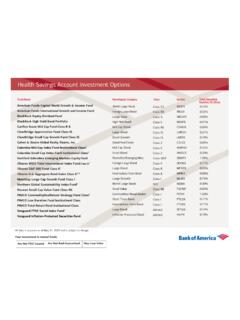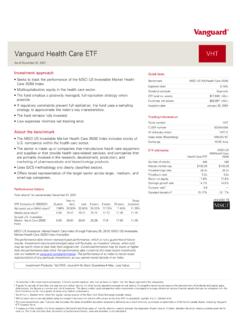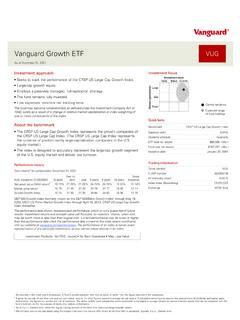Transcription of The framework for enhanced health in care homes
1 New care models The framework for enhanced health in care homes Our values: clinical engagement, patient involvement, September 2016. local ownership, national support #futureNHS. Version number: 1. First published: September 2016. Gateway publication reference: 05811. Equality and health inequalities statement Promoting equality and addressing health inequalities are at the heart of NHS England's values. Throughout the development of the policies and processes cited in this document, we have: given due regard to the need to eliminate discrimination, harassment and victimisation, to advance equality of opportunity, and to foster good relations between people who share a relevant protected characteristic (as cited under the Equality Act 2010) and those who do not share it; and given regard to the need to reduce inequalities between patients in access to, and outcomes from healthcare services and to ensure services are provided in an integrated way where this might reduce health inequalities.
2 The enhanced health in care homes framework 2. Contents Contents 3. 1 Introduction and summary 4. 2 Illustrating the care model 14. 3 Spreading the EHCH model 35. 4 Annexes and supporting material 43. Evaluation The enhanced strategy health forinnew carecare homes model framework vanguards - May 2016 3. 1 Introduction and summary Evaluation The enhanced strategy health forinnew carecare homes model framework vanguards - May 2016 3. 4. Introduction Across England, six vanguards are working to improve the quality of life, healthcare and planning for people living in care homes . One in seven people aged 85 or over is living permanently in a care home . The evidence suggests that many of these people are not having their needs properly assessed and addressed. As a result, they often experience unnecessary, unplanned and avoidable admissions to hospital, and sub-optimal medication. Within these six vanguard areas, care homes are working closely with the NHS, local authorities, the voluntary sector, carers and families to optimise the health of their residents.
3 The enhanced health in care homes (EHCH) care model is an adjunct to the other new care models that are delivering whole population healthcare. It will become a core element of the multispecialty community provider (MCP) and primary and acute care system (PACS) models. We have co-developed this document with the six EHCH vanguards and our partners in social care . The EHCH model is based on a suite of evidence-based interventions, which are designed to be delivered within and around a care home in a coordinated manner in order to make the biggest difference to its residents. Many of these interventions are well known. Some areas of the country will either have established some of these interventions already or will have been working towards them for a number of years. The work within the EHCH vanguards is therefore the culmination of many years' worth of work to improve the wellbeing and care of care home residents. By bringing a range of commissioners and providers together, solutions have been developed in a coordinated way, which has meant that vanguards can implement changes which would not be possible if done in isolation.
4 The enhanced health in care homes framework 5. Figure 1 - The six enhanced health in care homes (EHCH) vanguards Gateshead care home Project Airedale and Partners Nottingham City Clinical Commissioning Group Connecting care Wakefield District Sutton homes of care East and North Hertfordshire Clinical Commissioning Group The enhanced health in care homes framework 6. The wider context A primary goal of health and social care services is to support people in their own home for as long as possible. If this is no longer possible, we must ensure that the best possible care is provided to those in residential settings. In many parts of the country, the care for people who are living in care homes or who are at risk of losing their independence is being held back by a series of care barriers, financial barriers, and organisational barriers: care barriers - A narrow focus on medical rather than holistic needs - Lack of integrated care planning that focuses on prevention and pro-active care - Variable access for care home residents to NHS services - Lack of continuity of care and the difficulties faced by the current workforce crisis Financial barriers - Few system-wide incentives around preventative care across health and social care providers - A financially distressed care provider market which will impact on quality in some care homes - The financial challenges that the national living wage and other centrally imposed cost increases put on the finances of the providers and local authority/clinical commissioning group commissioners - Recruitment and retention (including training)
5 Within the care sector - Contractual mechanisms for provision of preventative health care for those in care homes and those at risk of losing their independence Organisational barriers - Barriers between organisations in different parts of the health service and between the NHS and other sectors, in particular social care - A lack of financial and clinical accountability for the health of the defined population - Variations in policy, process and supporting systems (such as information technology (IT)). across organisations. This new care model seeks to overcome as many of these challenges as possible by ensuring that: people have access to enhanced primary care and to specialist services;. budgets and incentives are aligned so that all parts of the system are unequivocally focussed on improving people's health and wellbeing;. the working environment is optimised for staff employed by social care providers so that they feel at the heart of an integrated team that spans primary, community, mental health , and specialist care , as well as social care services and the voluntary sector.
6 People maintain their independence as far as possible by reducing, delaying or preventing the need for formal social care services;. health and social care services are commissioned in a coordinated manner, and the role of the social care provider market is properly understood by commissioners and providers across health and social care . The enhanced health in care homes framework 7. This EHCH framework applies equally to people who self-fund their care and to people whose care is funded by the NHS or their local authority: everyone has the right to high quality NHS. services. The footprint' of an EHCH is all of the care homes (residential and nursing) that are situated in the planning footprint that chooses to implement the EHCH model, be it a sustainability and transformation plan (STP) area, a clinical commissioning group (CCG), a local authority or an MCP or PACS. Its scope may therefore include certain reablement and rehabilitation services that are provided in the community and which are aimed at avoiding unnecessary admission to hospital or into a care home ; however, all aspects of the care described in this framework will need to be tailored to local circumstances and to each individual person's care needs.
7 In order to help deliver a person-centred approach to care and support, the emerging EHCH. framework draws on both the I statements' (published by the Think Local, Act Personal' (TLAP). partnership that spans the health and social care sector) and the 'My home Life' initiative (that promotes quality of life and delivers positive change in care homes for older people). Through the process of developing the EHCH care model, we have also become aware of a range of small, big ideas'. These are defined as simple ideas that - if done well and replicated elsewhere - will not by themselves solve the significant issues being faced but may improve the quality and outcomes of care for care home residents. What all of these frugal innovations have in common is that they are simple, and replicable. The enhanced health in care homes framework 8. Figure 2 - Principles of a successful enhanced health in care homes care model Principles of a successful enhanced health in care homes care model The EHCH vanguards have identified the following conditions which are critical for success.
8 Person-centred change - Putting the needs of the resident or person with care needs at the centre of any changes - Supporting carers and families as well as those with care needs Co-production - Working and integrating with local government, the community and the voluntary and care homes sectors to co-design and co-deliver the model of care - Acknowledging the value of the care home sector in supporting the NHS and the significant level of healthcare that is delivered in care homes by social care staff - Adopting a whole-system approach, breaking down organisational barriers between health , social care and the voluntary sector Quality - A focus on quality as the driving factor for change - Using clinical evidence to support as well as drive change Leadership - Strong leadership and a joint shared vision for better care - Recognising the cultural differences between organisations and different types of commissioner and provider and focussing on the shared care aims despite differences in language and process.
9 The principles of establishing a successful EHCH care model apply equally to all people living in care homes and those who require support to live independently in the community or who are at risk of losing their independence. The enhanced health in care homes framework 9. Purpose of this framework This document describes: the seven core elements of the EHCH model and how they can be commissioned to deliver joined-up services, and the fully mature EHCH model We seek to inform four principal audiences: care home providers and managers (nursing, residential and supported living);. local authority and CCG leaders who are responsible for commissioning care home services;. partner organisations in community, mental health , and acute sectors of the NHS, and in the community and voluntary sector; and individuals with care needs, carers and families. We hope that this framework will be of interest to all stakeholders who are interested in working collaboratively across organisational boundaries to commission or deliver high quality, cost-effective care for individuals in the place of their choice.
10 We make clear the challenges facing each of the six EHCH vanguards as they navigate the many fragmented health and care services available to care homes and present the opportunities they have seized through collaboration and integrated working. We describe their journey towards delivering the fully mature EHCH model. Working collaboratively with the six care home vanguards, we have identified seven core elements that describe the EHCH care model. All of these elements are recognised as existing good practice; therefore, the EHCH care model is about implementing them together in a coordinated, sustainable way, at scale to deliver person-centred care that promotes independence. Table 1 sets out the care element and sub-elements which comprise the care model. The EHCH framework forms part of a suite of frameworks that also cover other models within the new care models programme: multispecialty community providers (MCPs), primary and acute care systems (PACSs) and acute care collaboratives (ACCs).














